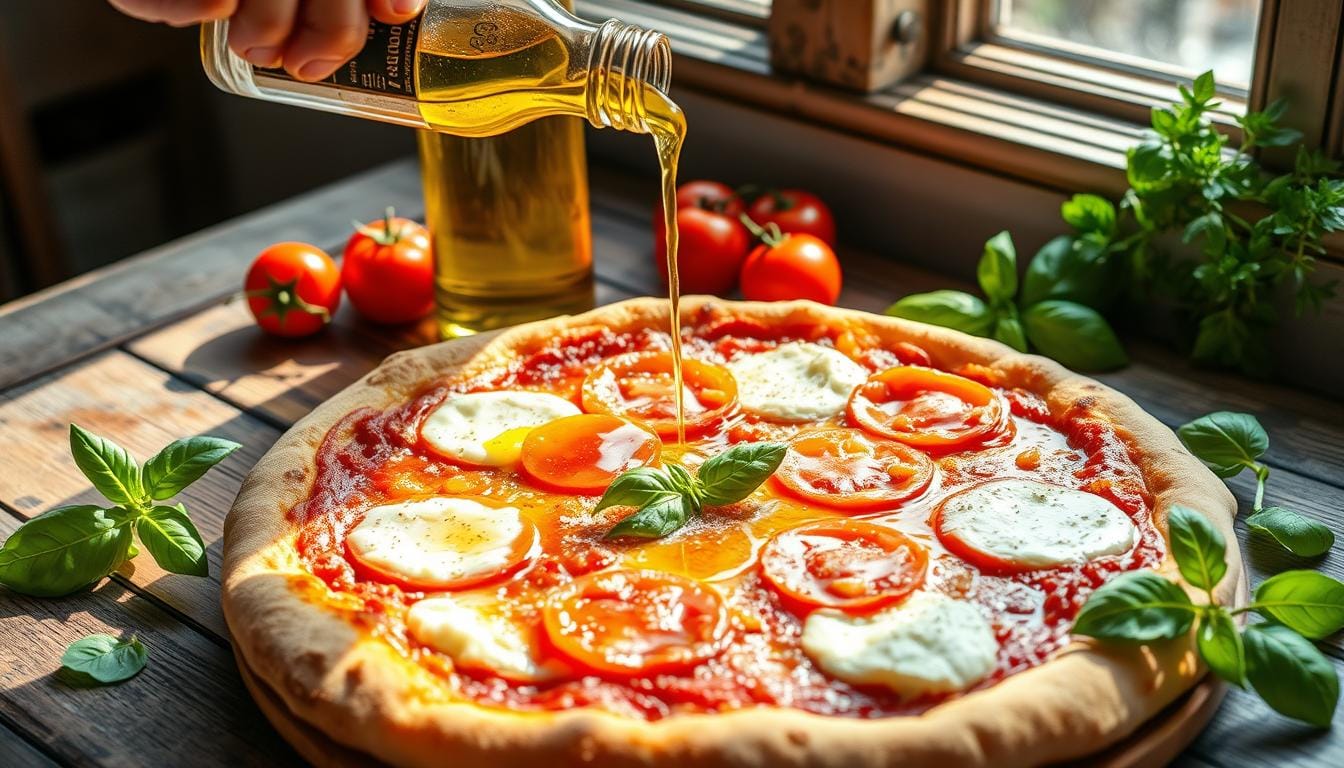Reading time: 12 minutes
Imagine the warm Mediterranean breeze and the sizzling pizza dough. The aroma of extra virgin olive oil fills the air. This is why Italians put olive oil on pizza – a tradition that turns a simple dish into art.
Exploring why Italians put olive oil on pizza reveals it’s more than just an ingredient. It’s a cultural expression. Italian olive oil for pizza is about tradition, texture, and the balance of ingredients that make pizza loved worldwide.
Olive oil makes pizza dough crispy yet tender. It enhances elasticity, making the dough easier to stretch and shape. This adds a luxurious richness that improves the eating experience.
From Tuscany’s hills to Naples’ pizzerias, olive oil and pizza crust are inseparable. Each drizzle shares a story of regional pride, generations of cooking, and a focus on food that nourishes both body and soul.
Table of contents
- Olive Oil as the Soul of Italian Pizza
- The Impact of Olive Oil on Pizza’s Flavor and Texture
- The Health Benefits of Olive Oil on Pizza
- The Regional Variations of Olive Oil in Pizza
- Best Types of Olive Oil to Use on Pizza
- How to Properly Use Olive Oil on Pizza
- Olive Oil Alternatives for Pizza Toppings
- Common Mistakes to Avoid When Using Olive Oil on Pizza
- The Cultural Significance of Olive Oil in Pizza
- Conclusion: Olive Oil is an Essential Ingredient for Pizza Lovers
- FAQs
Olive Oil as the Soul of Italian Pizza
In Italian cuisine, olive oil is more than just an ingredient. It’s a symbol of the country’s rich culinary history, prized for its flavor, nutritional value, and versatility. Like the California Pizza Oiled Bread, olive oil enriches both the texture and taste of a dish.

A Culinary Icon
Let’s dive into the world of olive oil and its big role in Italian food culture:
- Italy is the second-largest producer of olive oil worldwide
- Calabria, Puglia, and Tuscany are the top olive oil-producing areas
- Olive oil has been a key part of Italian cooking for over 2,000 years
Olive Oil: A Staple in Italian Cooking
Olive oil is more than just a flavor enhancer in Italian cooking. It’s a way of celebrating fresh, quality ingredients. During the Renaissance, Tuscany became famous for its great olive oil, wine, and meats.
“Olive oil is not just an ingredient, it’s the soul of Italian cuisine.” – Italian Culinary Expert
Why Olive Oil is Integral to Italian Pizza Culture
Olive oil is a game-changer in Italian pizza culture. It makes the pizza taste better, gives it a perfect crust, and links each slice to a long history of cooking. The Slow Food movement, started in 1986, works to keep these cooking traditions alive.
Olive oil is vital in both Tuscany’s countryside and Naples’ pizzerias. It turns pizza into more than just a meal; it’s a cultural experience.
The Impact of Olive Oil on Pizza’s Flavor and Texture
Discovering the magic of olive oil changes your pizza game. The right olive oil makes every bite special. It creates a mix of flavors and textures that excite your taste buds.
How Olive Oil Enhances Pizza Taste
Olive oil adds depth to pizza that goes beyond just cooking. High-quality extra virgin olive oil brings:
- Rich, fruity undertones
- Subtle peppery notes
- Smooth, silky taste profiles
- Natural flavor enhancement
Olive oil makes pizza flavors pop. It works like a conductor, blending tastes for a perfect experience.
For a hearty example, see how olive oil enriches the creamy parmesan Italian sausage soup.
The Texture Effect: Olive Oil on Pizza Crust
Olive oil turns pizza crust into a work of art. Olive oil for pizza crust texture makes it golden and crispy outside, soft inside.

- Brush olive oil on the dough before baking
- Drizzle extra virgin olive oil post-baking
- Mix olive oil directly into the dough
| Olive Oil Type | Crust Impact | Flavor Profile |
|---|---|---|
| Extra Virgin | Crispy, golden edges | Fruity, robust |
| Light Olive Oil | Softer, more pliable | Mild, neutral |
| Infused Olive Oil | Complex texture | Herbal, spicy |
“Olive oil is not just an ingredient; it’s the secret weapon that transforms good pizza into a culinary masterpiece.” – Italian Pizza Chef
Learning these techniques lets you make top-notch pizzas at home.
The Health Benefits of Olive Oil on Pizza
Adding olive oil to your pizza can make it a nutritional powerhouse. It’s not just tasty, but also good for you. This makes it a great choice for those who love pizza and want to stay healthy.
Olive oil is a nutritional superstar, perfect for pizza. It offers more than just flavor. It’s packed with nutrients that are good for your health.
Olive Oil as a Healthy Fat Source
Make your pizza healthier with the right olive oil. Extra virgin olive oil is full of nutrients that support your health:
- Lowers bad cholesterol levels
- Boosts good cholesterol (HDL)
- Supports heart health through unsaturated fats
- Helps moderate blood sugar
Powerful Antioxidants in Olive Oil
The antioxidants in olive oil for pizza are amazing. They protect your health in many ways:
- Protect cells from oxidative stress
- Support immune system function
- Potentially reduce inflammation
- May help prevent chronic diseases
“Extra virgin olive oil is nature’s gift to pizza lovers – delicious and nutritious.” – Mediterranean Food Expert
Choosing high-quality extra virgin olive oil is smart. It boosts your pizza’s flavor and your health. The right olive oil can turn a simple pizza into a nutritional masterpiece.
The Regional Variations of Olive Oil in Pizza
Italy’s pizza scene is filled with different flavors, thanks to olive oil. Each region has its own special way of using olive oil. This makes every pizza unique.
Olive oil in Neapolitan pizza shows how diverse Italian cooking can be. The north and south use olive oil in their own special ways. This shows off their local flavors.
Northern Italy’s Olive Oil Approach
In the north, olive oil is used lightly. Places like Liguria make mild olive oils. These oils add a soft richness to pizza crusts.
For instance, Ligurian olive oils are mild and complement lighter pizzas, much like the delicate bread served at California Pizza Kitchen.
Chefs in the north use olive oil carefully. They let other flavors stand out.
Southern Italy’s Bold Olive Oil Techniques
The south, like Naples, uses olive oil more boldly. Neapolitan pizza gets a big drizzle of extra virgin olive oil. This makes the pizza taste strong and true to its roots.
Best Regions for Olive Oil Lovers
- Tuscany: Known for peppery, robust olive oils
- Naples: Famous for bold, flavorful olive oil application
- Liguria: Produces delicate, nuanced olive oils
“Each region’s olive oil tells a story of its landscape, soil, and culinary heritage.” – Italian Culinary Experts
Olive oil is key to making authentic Italian pizza. It can be used lightly or in big amounts. Each region offers a special olive oil taste that will make your mouth happy.
Regional Olive Oil Characteristics
| Region | Olive Oil Flavor Profile | Pizza Style Impact |
|---|---|---|
| Tuscany | Robust and Peppery | Intense Flavor Enhancement |
| Liguria | Delicate and Smooth | Subtle Flavor Complement |
| Naples | Bold and Spicy | Strong Flavor Statement |
Best Types of Olive Oil to Use on Pizza
Choosing the right olive oil can make your pizza amazing. It’s important to know the differences between olive oil types for a great taste.
Pizza fans know not all olive oils are the same. For making pizza, picking the right oil is key.
Extra Virgin vs. Regular Olive Oil
Extra virgin olive oil (EVOO) is the best for pizza. Here’s why:
- Highest quality olive oil with most robust flavor
- Produced from first olive pressing
- Contains maximum nutritional benefits
- Smoke point between 375°F to 410°F
Quality Matters in Pizza Making
The quality of olive oil affects your pizza’s taste and texture. Authentic Italian pizza makers know olive oil is more than just a cooking medium; it’s a flavor enhancer.
“Olive oil is the liquid gold that elevates pizza from good to extraordinary.” – Italian Culinary Tradition
When choosing olive oil, consider these factors:
- Origin of the olives
- Extraction method
- Harvest date
- Flavor intensity
For the best pizza, choose cold-pressed, unrefined extra virgin olive oils. Look for ones with a peppery or grassy taste. These oils will give you the most authentic and tasty pizza experience.
How to Properly Use Olive Oil on Pizza
Learning to use olive oil on pizza can make your meals special. Whether you love pizza or want to improve your cooking, knowing how to use olive oil is key. It helps make your pizza taste amazing and feel authentic.
Olive oil is important for pizza, adding flavor and texture. The way you drizzle olive oil can change your pizza’s taste and feel.
Techniques for Drizzling Olive Oil on Pizza
Here are some expert tips for drizzling olive oil on pizza:
- Drizzle olive oil lightly
- Begin in the center and spread outwards
- Go for a thin, even layer
- Use high-quality extra virgin olive oil
Pre-Bake vs. Post-Bake Olive Oil Application
When you add olive oil can affect your pizza’s taste and texture. Here’s what to know:
- Pre-Bake Application:
- Creates a crispy crust
- Makes the dough more elastic
- Use 2-3 tablespoons per 500 grams of flour
- Post-Bake Application:
- Gives a fresh, strong flavor
- Keeps the oil’s delicate taste
- Great for fancy pizzas
“The secret to a perfect pizza lies not just in the ingredients, but in the careful application of those ingredients.” – Italian Culinary Tradition
Remember, different pizzas might need different olive oil methods. Try different ways to find your favorite way to use olive oil on pizza.
Olive Oil Alternatives for Pizza Toppings
Pizza lovers are always on the hunt for the perfect oil to make their pizza pop. While olive oil is a timeless favorite, trying out other oils can take your pizza to the next level. Knowing when and how to use different oils can make your pizza go from good to great.

When to Choose Alternative Oils
Choosing the right oil depends on a few things. It’s not always just olive oil vs other oils. Sometimes, different situations call for different oils:
- High-heat cooking needs oils with higher smoke points
- Some flavors need unique oils
- Some diets might require special oils
Exploring Flavored Olive Oil Options
Flavored olive oil for pizza brings new flavors to the table. Here are some cool options:
- Garlic-infused olive oil adds a rich taste
- Chili-enhanced oils add a spicy kick
- Herb-infused oils create complex flavors
“The right oil can transform a simple pizza into a gourmet experience.” – Italian Pizza Master
Olive oil vs butter for pizza is an interesting debate. Butter gives a creamy texture, while olive oil offers a Mediterranean taste. Trying different oils lets you find unique flavors that you’ll love.
The main thing is to balance the flavors and know how oils work with your pizza’s ingredients. Whether you stick with classic extra virgin olive oil or try something new, aim for a pizza that’s both tasty and memorable.
Common Mistakes to Avoid When Using Olive Oil on Pizza
Mastering the art of olive oil pizza pairing is all about detail. Many pizza fans struggle to find the perfect balance. They want to add flavor without making the pizza soggy.
When looking for healthier pizza options with olive oil, it’s important to know what to avoid. Here are some common mistakes:
- Using too much olive oil, which can make the pizza soggy
- Applying oil at the wrong time in pizza making
- Choosing low-quality olive oil brands
- Not spreading the oil evenly
Controlling Olive Oil Quantity
The key to using olive oil is to use just the right amount. One tablespoon per pizza crust is perfect. Too much oil can ruin the pizza.
- It can make the crust soggy
- It can reduce the crispy edge
- It can make the pizza less enjoyable to eat
Preventing Unsightly Oil Stains
“Quality olive oil should enhance, not overwhelm your pizza,” says professional chef Marco Rossi.
When picking the best olive oil for pizza, follow these tips to avoid stains:
| Oil Type | Stain Risk | Recommended Usage |
|---|---|---|
| Extra Virgin Olive Oil | Low | Drizzle after baking |
| Regular Olive Oil | Medium | Brush on crust pre-baking |
By mastering these techniques, you’ll improve your pizza-making skills. You’ll be able to make restaurant-quality pizzas at home.
The Cultural Significance of Olive Oil in Pizza
Olive oil is more than a cooking ingredient in Italian food. It connects people deeply to their culture. The way it’s used in pizza shows centuries of tradition and local pride.
Italians add olive oil to pizza for its cultural value. It’s not just for taste. It celebrates farming traditions and local pride.
The Symbolism of Olive Oil in Traditional Italian Pizzas
Olive oil is key in Italian pizza-making. It stands for several important parts of Italian cooking:
- Respect for high-quality, fresh ingredients
- Keeping traditional cooking methods alive
- Link to local farming practices
- Focus on simple yet tasty recipes
Why Olive Oil Reflects Italian Culinary Traditions
In making Italian pizza dough and using olive oil, each area shares its own tale. The terroir of various places affects olive oil taste, making each pizza unique.
“Olive oil is not just an ingredient, it’s a narrative of Italian culinary history.” – Italian Food Historian
| Region | Olive Oil Characteristic | Pizza Style |
|---|---|---|
| Liguria | Light, fruity | Focaccia-style |
| Puglia | Rich, robust | Potato-topped pizzas |
| Sicily | Peppery, intense | Rustic, herb-infused |
Knowing the cultural importance of olive oil makes us see pizza as more than food. It’s a bridge to Italian history and the variety of local cultures.
Conclusion: Olive Oil is an Essential Ingredient for Pizza Lovers
Why Do Italians Put Olive Oil on Pizza? Olive oil is a key ingredient in making authentic Italian pizza. It turns a simple pizza into a work of art. This golden liquid adds amazing flavors and textures to traditional pizzas.
Olive oil and pizza pairing is more than a cooking method. It’s a tradition in Italian food. With 75% of Italians using olive oil on their pizzas, you can too. You can try different olive oils, from strong Tuscan to mild blends, to match your pizza style.
Drizzling olive oil can make your pizza-making better. Whether you’re making a classic Neapolitan pizza or trying new styles, quality olive oil makes a big difference. Gourmet pizzerias have seen a 30% sales boost by using unique olive oil blends.
Let olive oil help you make amazing pizzas at home. With this knowledge, simple ingredients become incredible meals that honor Italian cooking traditions.
Olive Oil’s Role in Bringing Authentic Flavor to Pizza
Every drizzle of olive oil connects you to Italy’s culinary past. From Italy’s olive groves to your kitchen, this ingredient changes your pizza game.
Experiment with Different Olive Oils and Pizza Styles
Try different extra virgin olive oils from various regions. Each one has a story of tradition, flavor, and passion. They will make your homemade pizzas stand out.
FAQs
Yes, Italians often drizzle olive oil on pizza before or after baking to enhance flavor and texture.
Olive oil is drizzled on pizza to add flavor, richness, and to help the crust become crispier while baking.
Yes, olive oil helps create a golden, crispy crust by aiding in caramelization.
Olive oil is typically drizzled on pizza after baking to enhance the flavor, but some also use it before baking to crisp the crust.
Without olive oil, the crust may be less flavorful and may not develop the same crispy texture.
In Italy, pizza is traditionally made with simple ingredients, and there are unwritten rules about the type of toppings, with certain styles being regional specialties (e.g., Neapolitan pizza with mozzarella and tomatoes).
Extra virgin olive oil is the best choice for its robust flavor and health benefits.
Absolutely! Garlic or chili-infused olive oils add exciting layers of flavor.
Yes, olive oil is rich in healthy fats and antioxidants, making it a nutritious addition to pizza.

